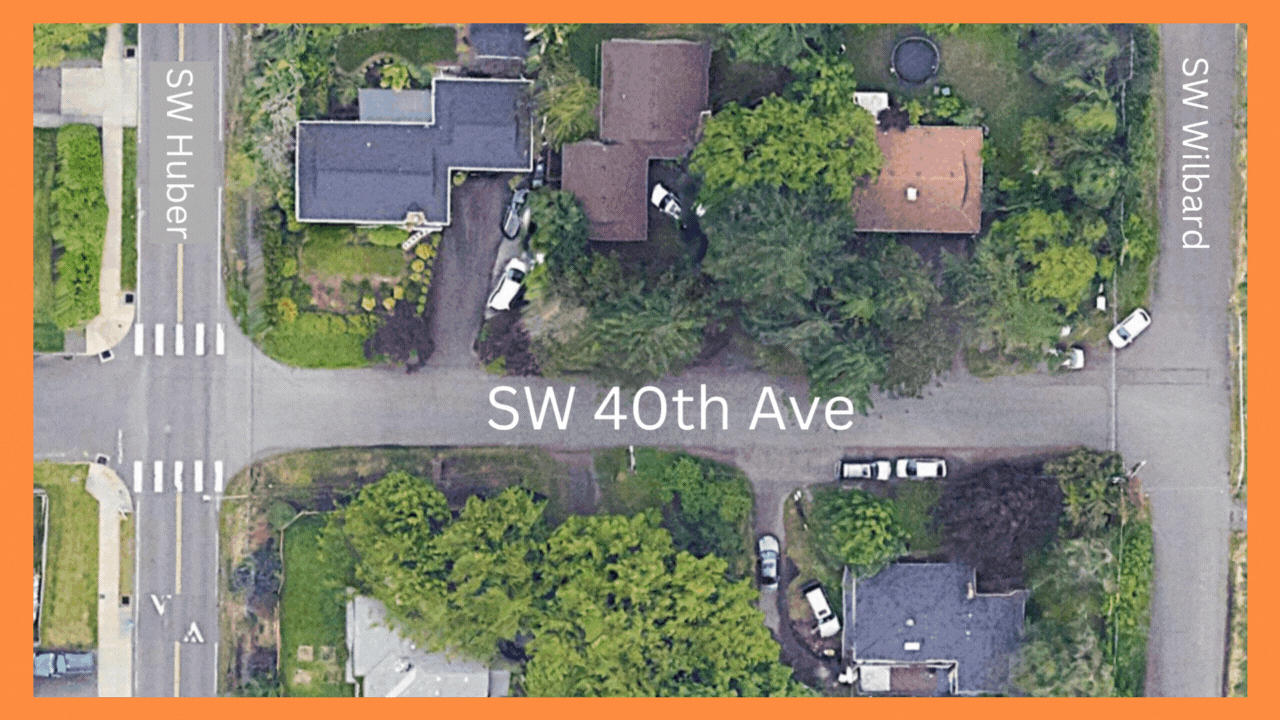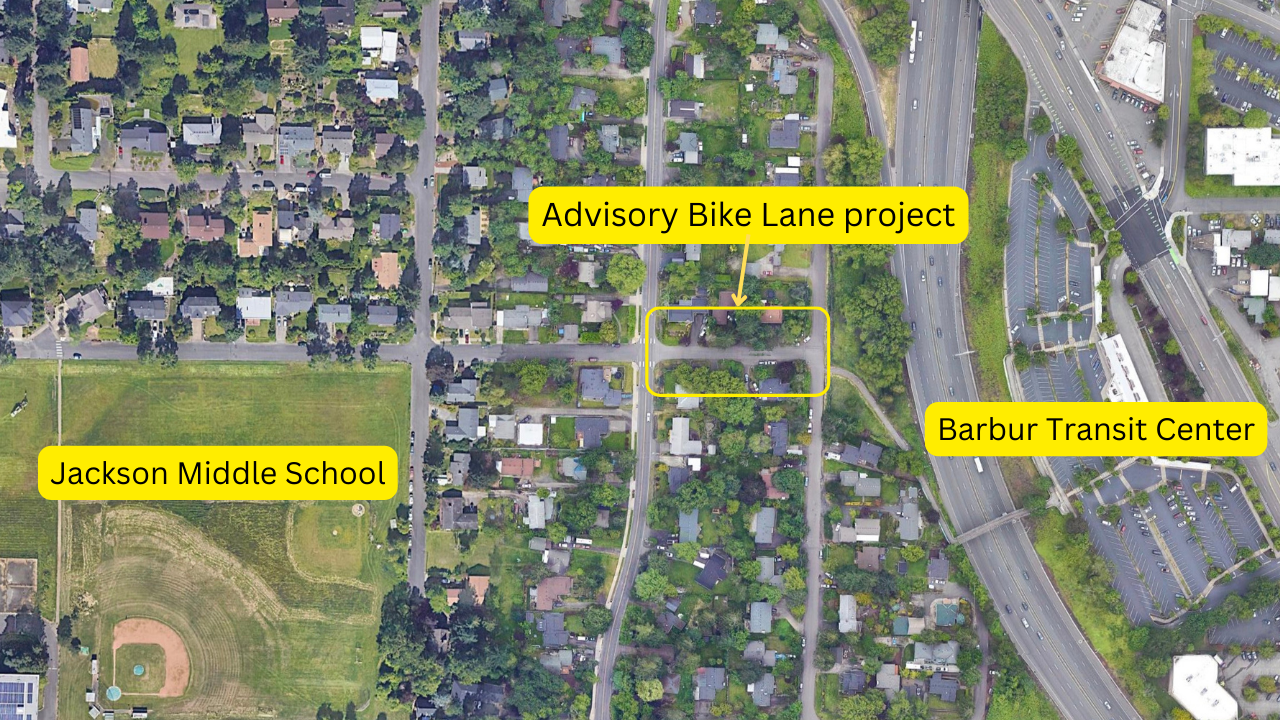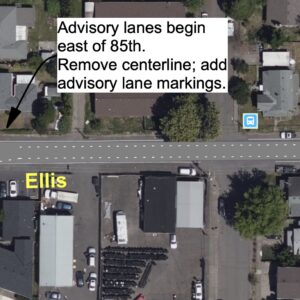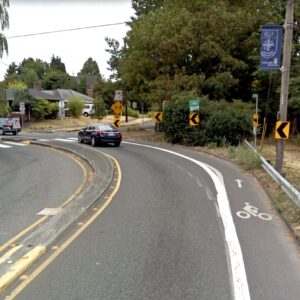
(Editor’s note: PBOT uses the terms “advisory bike lane” and “advisory shoulder,” but there’s almost no difference in the design. They choose the term based on whether or not street has a curb. If there’s a curb and/or a sidewalk, they call it an “advisory bike lane.” No curb, and it’s a shoulder lane. BikePortland will stick with “advisory bike lane” because I find it provides the most clarity.)
Back in April we shared news that the Portland Bureau of Transportation would install three advisory bike lane projects this year. Now we’ve learned that two of those are postponed and one will move forward.
The project on SW 40th between Huber and Wilbard has been planned and designed and will be installed late this year or in early 2024 according to PBOT’s updated website.


As I shared in April, the SW 40th project is just one block, but will create dedicated cycling space between Jackson Middle School and a pedestrian walkway over I-5 that feeds directly into the Barbur Transit Center. This is a low-volume, low-speed street that currently has no lane striping of any kind. The idea behind these advisory bike lane projects is that they provide stronger cues for how the road can be used.
As you might have seen in our previous coverage, advisory bike lanes use a dashed striping pattern instead of a solid white line. They are implemented on streets that have two directions of car traffic, but PBOT doesn’t feel there’s adequate width to stripe standard bike lanes on both sides. So the idea is that, if no bike riders or walkers (in the event there’s no sidewalk) are present, people can drive onto the bike lane and use the street as they always would have. However, if a bike rider or walker is present, the street becomes a shared environment where drivers must yield to advisory lane users and wait before making a safe pass.
This design has a lot of potential in southwest Portland because of the high number of low-volume streets where PBOT is unlikely to ever stripe conventional bike lanes.
The SW 40th project plans (below) show that PBOT will stripe the entry to each end of the block with a sharrow and a short double-yellow line. Then it will transition into the shared, advisory environment for most of the block.

Along with revealing plans for 40th, PBOT has also announced that the two other advisory bike lane projects planned to be installed this year — on SW Talbot from SW Fairmount to SW Gaston and SE Ellis from SE 84th to SE 92nd — are delayed “while additional pavement condition assessment and neighborhood outreach takes place.”






Thanks for reading.
BikePortland has served this community with independent community journalism since 2005. We rely on subscriptions from readers like you to survive. Your financial support is vital in keeping this valuable resource alive and well.
Please subscribe today to strengthen and expand our work.
This project to me honestly feels like a waste of time and money. It is a low volume street that basically connects to nothing. It won’t change anything about the modal share of that area. It doesn’t even really change the nature of street or make any concrete changes to the safety environment. It is basically performance theater for activists.
“connects to nothing”
It is literally between a huge public school, a pedestrian path and a transit center on a major arterial.
And obviously it’s a tiny little project, but this is what building out a bike network looks like. It takes a lot of little things to make a big thing. I realize posting it here gives it a certain weight, but yes, it is a small project. That doesn’t mean it’s a “waste” in my opinion. Not by any stretch.
That block of SE 40th they are painting is essentially a dead end that services ~40 households. So we’re spending time and money to paint a street that maybe sees 10 car trips per hour if not less. There are probably over 1000 if not more blocks in this city that would benefit cyclist more from the same resources.
If anything advisory lanes for bikes are maybe even more detrimental to cyclists. It is telling us cyclist that we aren’t entitled to have ownership of the roadway and placing us on the margin of the road so that cars can whiz by. These lines don’t do anything to change the mentality of car drivers. It is to tell bike riders to get f out the way.
This is a crumb to satiate activists while maintaining the status quo.
Jonathan, SECommuter is right and you are wrong, I’m afraid.
This project will do nothing. Any kid can ride this block now with no fear. It’s NOT a vital connection, though it may look like it on a map.
Come over and ride it and see what I’m talking about. It’s a completely low-stress block and you will ride it and not even realize you did.
cool. I really don’t care about being right. I’m just saying that I disagree it’s a “waste”. Right now PBOT is still experimenting with this treatment so the more they deploy it the more experience they’ll get. It’ll cost a few thousand bucks and it’s not that big of a deal. Again, I’m not trying to overstate its importance or say it’s a huge deal. I’m just saying it’s a cool treatment and it’s worthwhile. Not everything is zero-sum. Doing this doesn’t hurt anyone!
Hmm – I just heard a lot of us making a zero-sum argument about the 33rd Ave bike lane, as in: The $$ you spend on removing these bike lanes are $$ PBOT desperately needs elsewhere. But now it’s okay to spend $$ on street treatments we don’t need?
Maybe you don’t fully appreciate this issue b/c you don’t live and cycle in SW, where unnecessary and performative street treatments are the order of the day, while the really critical needs continue to go unmet (Taylors Ferry, Huber, the Crossroads from Hell, and too many others to mention). PBOT is doing the easy, unneeded stuff in order to avoid doing the hard, necessary stuff in this part of town, while they tackle the harder projects east of the river. That’s a fact.
Totally agree with you, Fred. Funding came from the Barbur Demonstration Project that many of us spend many many hours fighting for back in 2012 and beyond. Then around 2017 PBOT yanked the funds and proposed to do four other projects, which the SWNI Transportation Committee prioritized, and the SW 40th one was on the bottom of our list. Our letter requested that they spend all of the funds on SW 26th and do it well, but they ignored that comment too. Then the funds somehow disappeared in half. Now the Barbur Demo Project “improvements” include a MUP on a very busy road (SW 26), a not-needed sidewalk on SW Custer, and a useless facility on a dead end street that doesn’t need it while others continue to be unsafe, including Barbur, and SW Taylors Ferry and many many others.
“If anything advisory lanes for bikes are maybe even more detrimental to cyclists. It is telling us cyclist that we aren’t entitled to have ownership of the roadway and placing us on the margin of the road so that cars can whiz by. These lines don’t do anything to change the mentality of car drivers. It is to tell bike riders to get f out the way.”
That doesn’t sound like something that “doesn’t hurt anyone”.
Performance theater is the normal kind of theater.
I can’t tell for sure but it looks like they’re adding sidewalks where there were none. That’s great. And explicit markings for bicyclists are useful if they’re part of a network, which this apparently is since it’s a route to school and transit center.
For the benefit of anyone else who was having trouble figuring out why a numbered street appeared to be running east/west, the maps are turned 90° clockwise.
Thanks – no wonder that map made no sense to me. Any navigator worth her salt will read maps north-up.
I actually use this! I never saw a car on SW 40th, or maybe I can’t recall it. If we could get some bike lanes on SW Huber or at least some traffic calming so that cars aren’t going 40 mph, that would be amazing. SW 35th is way better now, and I could see a real network forming. I really think that with the mass adoption of ebikes the hills in this area cannot be used as an excuse to keep it car dependent.
This is the gussied-up version of PBOT’s SW policy: you’ll get nothing and like it.
The little side streets like this aren’t the issue in hilly areas, it’s the CONNECTORS, which PBOT will do nothing about. Save the money and bank it towards solving the bigger problem.
Hot take but I actually like advisory bike lanes and think they are a good solution in a lot of places. Every time I’ve gone over I84 on 53rd it’s been just fine.
Yep – but this is no 53rd. It’s a dead-end street that goes to maybe 20 houses. We don’t need any road treatment to bike or walk safely here.
I bike here all the time, so let me just say that this project is a complete Nothing Burger.
There’s almost no vehicle traffic here – I’ve probably met two cars in 20 years of cycling on this block almost every day.
PBOT should abandon this project and devote the money to some high-impact project, since this project will improve cycling for absolutely no one. I wonder who is even asking for it? It fits perfectly with my thesis that PBOT is doing only easy projects in SW that meet two criteria:
Do not disrupt the car-dominant paradigm in any way;Put in lots of paint etc so you make it look like you’re doing something to promote cycling, when in fact the project does nothing.
It’s the apotheosis of performative Portland!
When I last checked a couple of years ago, Advisory Shoulders were experimental, and PBOT was deliberately looking for small streets that were already functioning like they had an advisory shoulder as a way of formalizing with paint what was already happening in practice. So 40th is a fine spot.
I’m only disappointed that the one on Talbot, near my house, is on hold. It also doesn’t “need it,” the street segment already functions as a “Shared Street” on sunny weekends, that is what makes it a safe street to introduce a new treatment.
Go advisory lanes!
Why do I suspect “See, the Advisory Lanes worked!” on these tiny test streets will by followed by this being official PBOT treatment for all SW roads – SW Shattuck, Dosch Oleson ad nauseum.
I suppose it would be an improvement over current policy of using the fog line to protct pedestrians and cyclists!
Yeah, I was gonna say, the status quo ain’t great. But I think an advisory shoulder can’t be on a fast street, and it also has to be narrow.
While on the surface level I’m in favor of this project and advisory bike lanes in general, I will say that my experience going on bike rides with my friends who are less wonk-y than me (ie, people who don’t read BikePortland) is that they simply don’t have the vocabulary, patience, and attention to keep up with the sheer number of “experiments” being conducted on cycling infrastructure on our streets. On a typical ride in SE I’ll pass through five drastically different approaches to intersection/street design, many of which are one of only one or two instances of that particular pattern in the whole city. You shouldn’t need to be an armchair urban planner to keep track of how to use our streets day-to-day!
I’m definitely a fan of experimentation in the abstract, but I have to wonder when, if ever, PBOT is going to commit to a standard & reliable design for our streets the way drivers have come to expect. It seems like so much ingenuity is applied mostly to the task of “how can we maneuver cyclists through our existing infrastructure with the most minimal impact on existing car traffic” mostly as a way to avoid the much harder question of how to build real bicycle-first-car-second roads in the current political climate. When are we going to start maneuvering cars around crucial bike infrastructure instead?
Words matter.
Why “Edge Lane Road” is a better name
Alternative names for this treatment are “Advisory Bike Lane” and “Advisory Shoulder”. Following are the reasons the “Edge Lane Road” name is a better choice:
• The name “advisory bike lane” creates a legal conflict. Most, if not all, states have laws defining bike lanes as facilities that exclude motor vehicles. This creates a conflict between existing laws and desired driver behavior.
• The terms “bike lane” and “shoulder” are terms-of-art. Per the MUTCD and state law, neither bike lanes nor shoulders are intended for vehicular travel. These definitions are important in technical, regulatory, and legal settings. Edge lane (road) is a new term and avoids the baggage of other terms.
• The essence of the treatment is not the type of vulnerable road user it supports; its essence is the space created by the edge lanes and the shared use behavior required of all road users.
• The “advisory” names imply the edge lanes have an existence independent of the entire road and that they can be added to any road. This has resulted in “advisory bike lanes” being added to roads with centerlines – a configuration worse than sharrows. ELRs only work as an inseparable whole. The treatment is a shared street, not individual lanes for VRUs.
• This treatment has the potential to reduce single-vehicle, roadway-departure crashes on rural, 2-lane roads even if they never see a vulnerable road user (see htps://www.advisorybikelanes.com/rural-edge-lane-roads.html). “Advisory Bike Lane” is not an appropriate name for this use.
• “Edge lane road” is already used in other countries. Danish guidance uses this name and residents of other countries are familiar with the terminology.
• Some folks use “Advisory Bike Lane” when bikes are the intended benefactors and “Advisory Shoulder” when pedestrians are supported. What do we call existing facilities that support both? What name is used when the treatment supports equestrians, wheelchairs, or horse-drawn buggies?
• Are you referring to the lanes or the entire road? The “advisory” names are used interchangeably to refer to the entire road and to the edge lanes – this can be confusing. “Edge lanes” refer to the outside lanes and “edge lane road” refers to the entire road.
This has been said in different ways, but these types of “improvements” look like excuses to not make the real changes that are needed in SW. Advisory bike lanes/shoulders don’t provide much and mean building sidewalks and real facilities can be ignored. Seeing how little the City invests in outer SW it’d be better to roll the funding for all of these small projects into one real project.